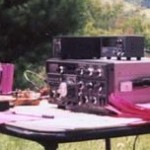Amateur radio is popular with young and old alike
“The reports of my death,” Mark Twain once famously quipped, “are greatly exaggerated.”
If you listen and read the comments offered in recent years, you’d swear that ham radio is on life support, or worse. Kids just aren’t interested in becoming ham radio operators the story goes, and why should they be? With the Internet, smart phones, and computer games, young people have too many other “fun” things to do and can communicate with just about anyone in the world instantaneously. Where in the world does amateur radio fit anymore?
Good question. True, the hobby has gone through great changes in recent years. The advent of sophisticated amateur radio equipment has eliminated the need for building one’s own station. Plug and play is the norm today. (Although many amateur radio operators—“hams” to us—still build their own mini radios, antennas, and other equipment.)
No, the days when a young boy—and it often was a boy back then—built his simple Morse code radio, tossed a wire into the nearby tree, and sent his dits and dashes all over the country are pretty much over. But amazingly many young people, boys and girls, are getting a ham radio license. Sure, they still tinker at home, but these spirited young people also contribute to their communities, and in the process derive as much or more satisfaction as before. (Shown is some of my ham radio equipment.)
Public service is extremely important to amateur radio operators, who regularly volunteer to help their fellow citizens. They provide much-needed communications support for charity walks and runs.
Ham radio operators really shine by providing emergency communications during natural and civil disasters. Amateur radio operators stand ready to respond any time of day, seven days a week. Among the many well-known disasters, ham radio operators have provided additional communication support during:
- Hurricane Katrina
- Hurricanes that hit Texas in 2008
- Most recently, Hurricane Isaac that pounded New Orleans and surrounding areas
How is this possible, especially when other modes of communication are inoperable? Ham radio operators use their own equipment, which operates on frequencies set aside for amateur radio. Sure, there are times when even ham radio operations are affected by the disaster, but more often than not the equipment functions well.
Amateur radio operators are assigned to relief stations and shelters, relief vehicles, command posts, roads and intersections, and anywhere else an extra set of eyes may be needed.
Hams use the latest technology, including digital and VoIP transmissions (using EchoLink). To hone their skills, they participate in ham radio contests and disaster drills. There truly is much more to amateur radio than you might imagine. (For a review of my equipment, see this column.)
You can learn more about ham radio and find a club in your area by visiting the website of the American Radio Relay League (ARRL). ARRL offers a wide range of books and other materials on every aspect of the hobby.
The next time you’re riding your bike to raise money for cancer research or some other noble cause, tip your helmet to the many ham radio operators who selflessly give of their time to help make your event a successful one. Look around: You may even spot a young person at the rest stop or finish line. They represent the future—yes, the future—of amateur radio.
Are you a ham radio operator? “Talk it up!” as we say. Feel free to comment on your experiences, whether during a public service or just hamming around. If you enjoyed this column, could you do me a favor and share it with others? Click on any of the buttons below. Thanks!
Follow me on Twitter.
Follow my Facebook business page.
Connect with me on LinkedIn.

